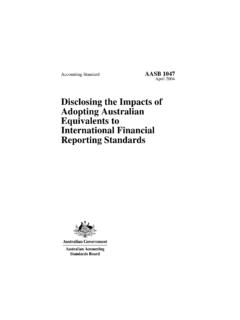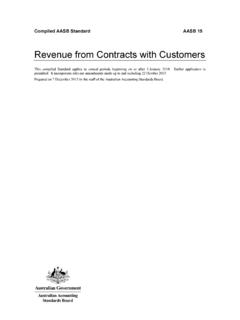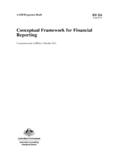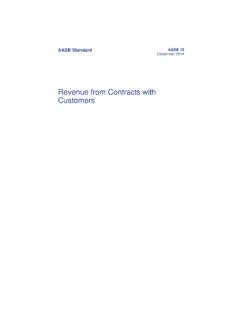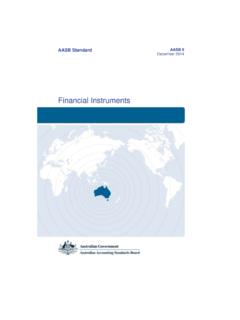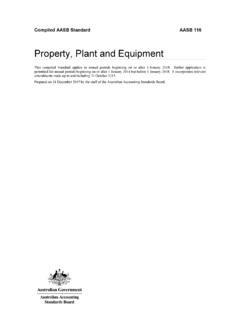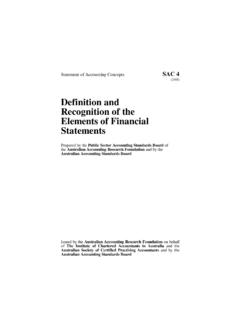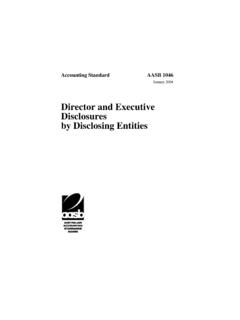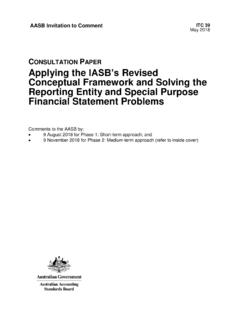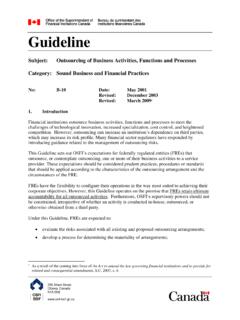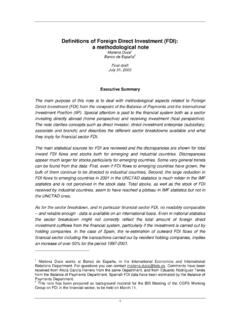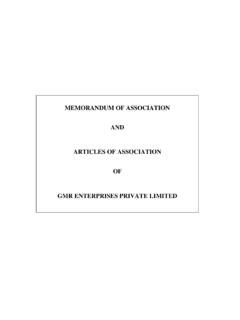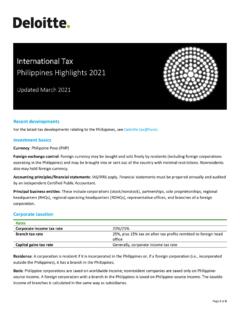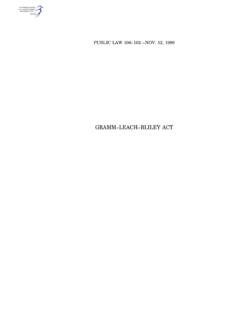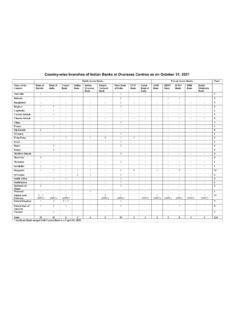Transcription of Income Taxes
1 AASB Standard AASB 112 August 2015 Income Taxes Federal Register of Legislative Instruments F2015L01601 AASB 112 2 COPYRIGHT Obtaining a copy of this Accounting Standard This Standard is available on the AASB website: Australian Accounting Standards Board PO Box 204 Collins Street West Victoria 8007 AUSTRALIA Phone: (03) 9617 7637 E-mail: Website: Other enquiries Phone: (03) 9617 7600 E-mail: COPYRIGHT Commonwealth of Australia 2015 This AASB Standard contains IFRS Foundation copyright material. Reproduction within Australia in unaltered form (retaining this notice) is permitted for personal and non-commercial use subject to the inclusion of an acknowledgment of the source.
2 Requests and enquiries concerning reproduction and rights for commercial purposes within Australia should be addressed to The Director of Finance and Administration, Australian Accounting Standards Board, PO Box 204, Collins Street West, Victoria 8007. All existing rights in this material are reserved outside Australia. Reproduction outside Australia in unaltered form (retaining this notice) is permitted for personal and non-commercial use only. Further information and requests for authorisation to reproduce for commercial purposes outside Australia should be addressed to the IFRS Foundation at ISSN 1036-4803 Federal Register of Legislative Instruments F2015L01601 AASB 112 3 CONTENTS Contents COMPARISON WITH IAS 12 ACCOUNTING STANDARD AASB 112 Income Taxes from paragraph OBJECTIVE SCOPE 1 DEFINITIONS 5 Tax base 7 RECOGNITION OF CURRENT TAX LIABILITIES AND CURRENT TAX ASSETS 12 RECOGNITION OF DEFERRED TAX LIABILITIES AND DEFERRED TAX ASSETS Taxable temporary differences 15 Business combinations 19 Assets carried at fair value 20 Goodwill 21 Initial recognition of an asset or liability 22 Deductible temporary differences 24 Goodwill 32A Initial
3 Recognition of an asset or liability 33 Unused tax losses and unused tax credits 34 Reassessment of unrecognised deferred tax assets 37 Investments in subsidiaries , branches and associates and interests in joint arrangements 38 MEASUREMENT 46 RECOGNITION OF CURRENT AND DEFERRED TAX 57 Items recognised in profit or loss 58 Items recognised outside profit or loss 61 Deferred tax arising from a business combination 66 Current and deferred tax arising from share-based payment transactions 68A PRESENTATION Tax assets and tax liabilities 69 Offset 71 Tax expense Tax expense ( Income ) related to profit or loss from ordinary activities 77 Exchange differences on deferred foreign tax liabilities or assets 78 DISCLOSURE 79 EFFECTIVE DATE 89 WITHDRAWAL OF SIC-21 99 COMMENCEMENT OF THE LEGISLATIVE INSTRUMENT WITHDRAWAL OF AASB PRONOUNCEMENTS APPENDIX A Australian reduced disclosure requirements ILLUSTRATIVE EXAMPLES Examples of temporary differences Illustrative computations and presentation DELETED IAS 12 TEXT Federal Register of Legislative Instruments F2015L01601 AASB 112 4 CONTENTS AVAILABLE ON THE AASB WEBSITE Basis for Conclusions on IAS 12 Australian Accounting Standard AASB 112 Income Taxes is set out in paragraphs 1 and Appendix A.
4 All the paragraphs have equal authority. Paragraphs in bold type state the main principles. AASB 112 is to be read in the context of other Australian Accounting Standards, including AASB 1048 Interpretation of Standards, which identifies the Australian Accounting Interpretations, and AASB 1057 Application of Australian Accounting Standards. In the absence of explicit guidance, AASB 108 Accounting Policies, Changes in Accounting Estimates and Errors provides a basis for selecting and applying accounting policies. Federal Register of Legislative Instruments F2015L01601 AASB 112 5 COMPARISON Comparison with IAS 12 AASB 112 Income Taxes incorporates IAS 12 Income Taxes issued by the International Accounting Standards Board (IASB).
5 Australian-specific paragraphs (which are not included in IAS 12) are identified with the prefix Aus or RDR . Paragraphs that apply only to not-for-profit entities begin by identifying their limited applicability. Tier 1 For-profit entities complying with AASB 112 also comply with IAS 12. Not-for-profit entities compliance with IAS 12 will depend on whether any Aus paragraphs that specifically apply to not-for-profit entities provide additional guidance or contain applicable requirements that are inconsistent with IAS 12. Tier 2 Entities preparing general purpose financial statements under Australian Accounting Standards Reduced Disclosure Requirements (Tier 2) will not be in compliance with IFRSs.
6 AASB 1053 Application of Tiers of Australian Accounting Standards explains the two tiers of reporting requirements. Federal Register of Legislative Instruments F2015L01601 AASB 112 6 STANDARD Accounting Standard AASB 112 The Australian Accounting Standards Board makes Accounting Standard AASB 112 Income Taxes under section 334 of the Corporations Act 2001. Kris Peach Dated 7 August 2015 Chair AASB Accounting Standard AASB 112 Income Taxes Objective The objective of this Standard is to prescribe the accounting treatment for Income Taxes . The principal issue in accounting for Income Taxes is how to account for the current and future tax consequences of: (a) the future recovery (settlement) of the carrying amount of assets (liabilities) that are recognised in an entity s statement of financial position; and (b) transactions and other events of the current period that are recognised in an entity s financial statements.
7 It is inherent in the recognition of an asset or liability that the reporting entity expects to recover or settle the carrying amount of that asset or liability. If it is probable that recovery or settlement of that carrying amount will make future tax payments larger (smaller) than they would be if such recovery or settlement were to have no tax consequences, this Standard requires an entity to recognise a deferred tax liability (deferred tax asset), with certain limited exceptions. This Standard requires an entity to account for the tax consequences of transactions and other events in the same way that it accounts for the transactions and other events themselves. Thus, for transactions and other events recognised in profit or loss, any related tax effects are also recognised in profit or loss.
8 For transactions and other events recognised outside profit or loss (either in other comprehensive Income or directly in equity), any related tax effects are also recognised outside profit or loss (either in other comprehensive Income or directly in equity, respectively). Similarly, the recognition of deferred tax assets and liabilities in a business combination affects the amount of goodwill arising in that business combination or the amount of the bargain purchase gain recognised This Standard also deals with the recognition of deferred tax assets arising from unused tax losses or unused tax credits, the presentation of Income Taxes in the financial statements and the disclosure of information relating to Income Taxes .
9 Scope 1 This Standard shall be applied in accounting for Income Taxes . 2 For the purposes of this Standard, Income Taxes include all domestic and foreign Taxes which are based on taxable profits. Income Taxes also include Taxes , such as withholding Taxes , which are payable by a subsidiary, associate or joint arrangement on distributions to the reporting entity. For public sector entities and for the purposes of this Standard, Income Taxes also include forms of Income tax that may be payable by a public sector entity under their own enabling legislation or other authority. These forms of Income tax are often referred to as Income tax equivalents . 3 [Deleted] 4 This Standard does not deal with the methods of accounting for government grants (see AASB 120 Accounting for Government Grants and Disclosure of Government Assistance or, for not-for-profit entities, AASB 1004 Contributions) or investment tax credits.
10 However, this Standard does deal with the accounting for temporary differences that may arise from such grants or investment tax credits. Federal Register of Legislative Instruments F2015L01601 AASB 112 7 STANDARD Definitions 5 The following terms are used in this Standard with the meanings specified: Accounting profit is profit or loss for a period before deducting tax expense. Taxable profit (tax loss) is the profit (loss) for a period, determined in accordance with the rules established by the taxation authorities, upon which Income Taxes are payable (recoverable). Tax expense (tax Income ) is the aggregate amount included in the determination of profit or loss for the period in respect of current tax and deferred tax.
